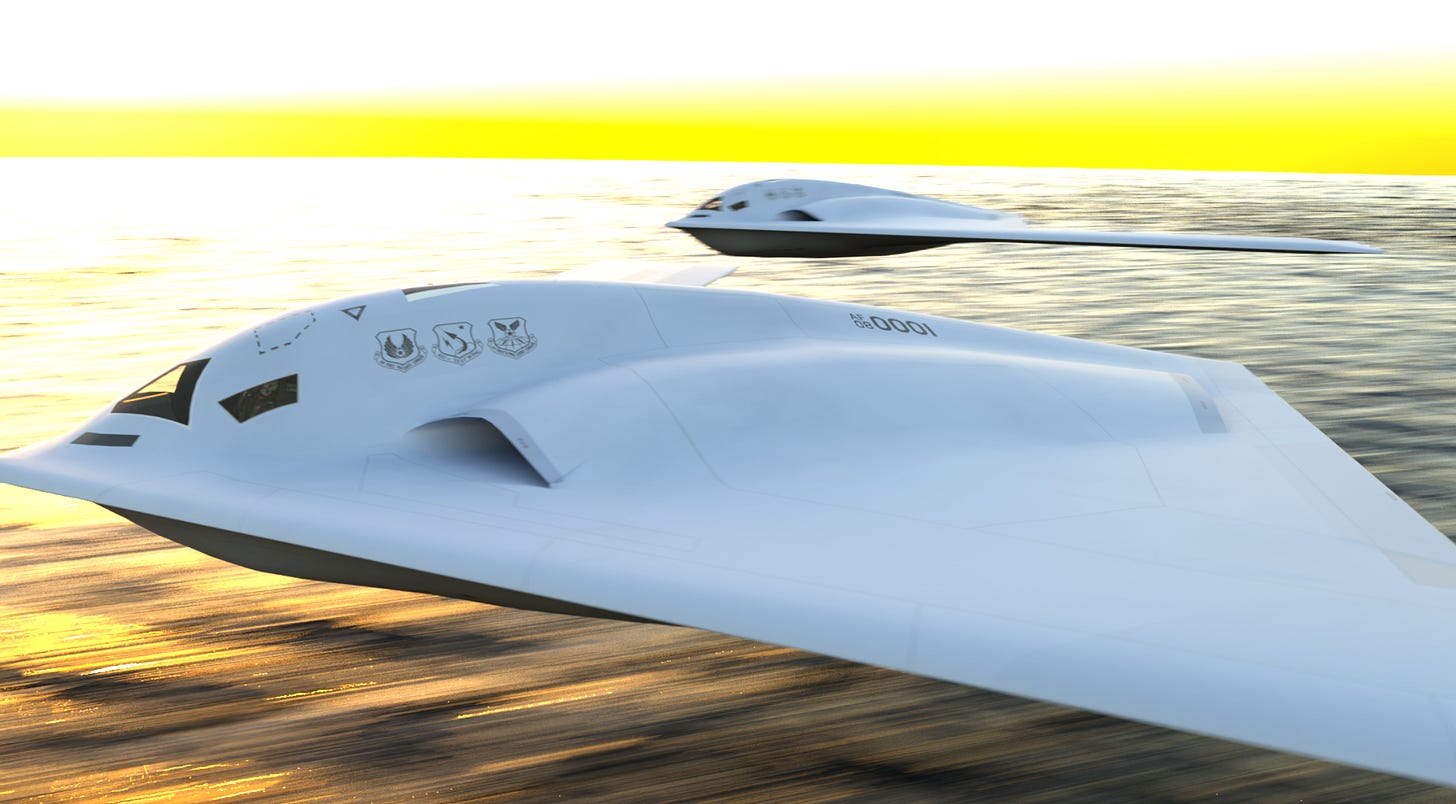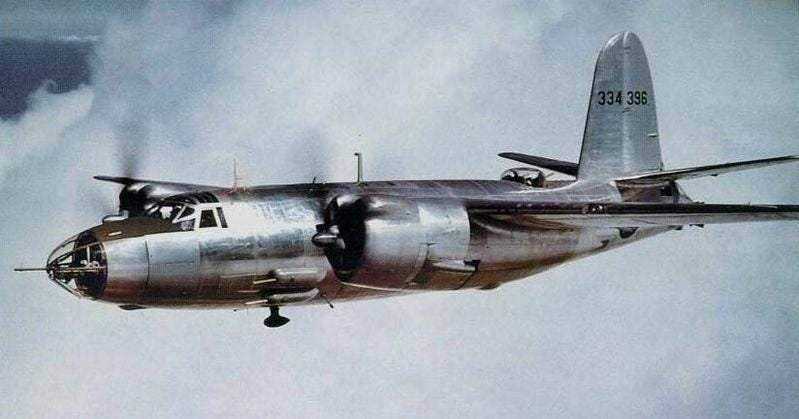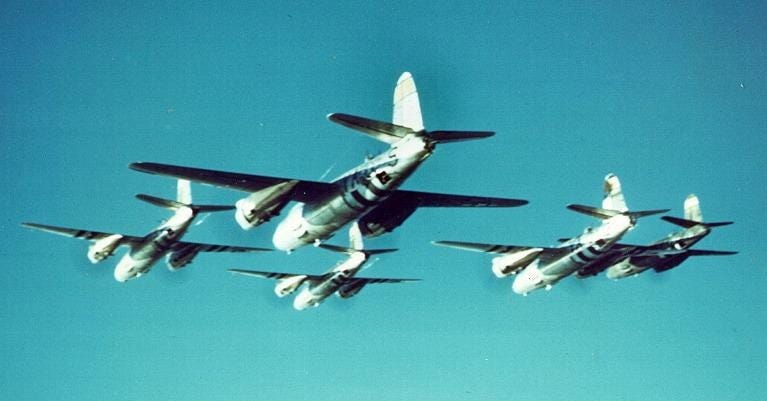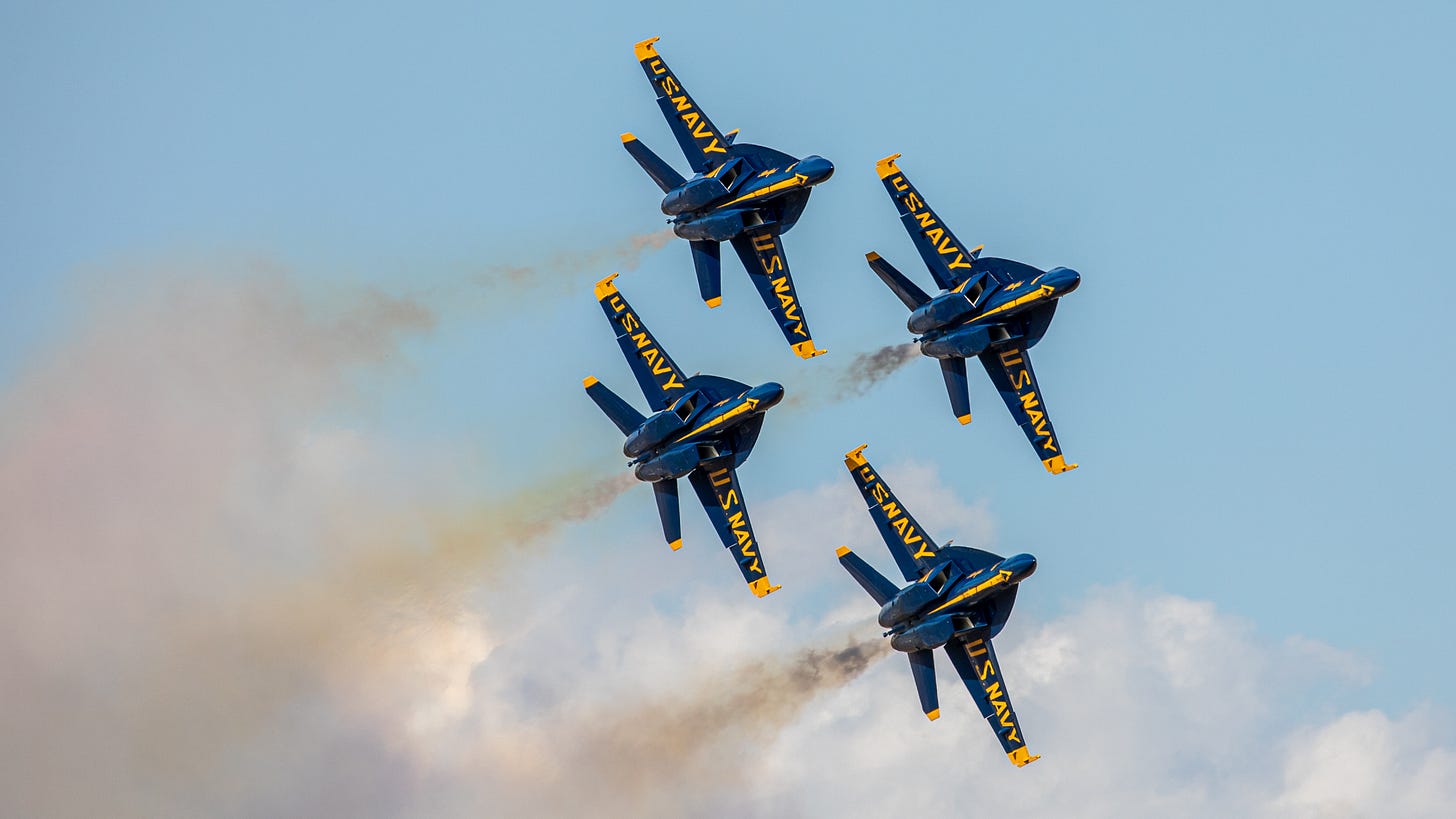The B-21 Raider Ushers in a New Era of Stealth, and the B-26 Cuts Through Pacific Clouds on its First Combat Mission
On November 23, 1942, the B-26 Marauder cuts through Pacific clouds on its first combat mission. Eight decades later, the B-21 Raider emerges—heir to that legacy, poised for a new era of Pacific power
“The B-21 Raider defines a new era in technology and strengthens America’s role of delivering peace through deterrence.” — Doug Young, Northrop Grumman executive.
There’s something familiar about settling into a new flight routine. The first sortie feels experimental, the second starts to feel like rhythm. As we taxi into week two of our expanded three-day publishing schedule, that rhythm is really beginning to take shape.
Last week marked the debut of our new cadence: Tuesday and Thursday issues for all readers, with the Midweek Sortie every Wednesday exclusively for paid members. This week we continue that pattern—three departures, three missions, each with its own purpose.
Thanks for strapping in for this new tempo. Let’s keep the momentum rolling.
Mission Briefing
They say when the B-21 Raider was unveiled that chilly December night in Palmdale, the hangar lights glinted off its midnight skin and you could feel the hush in the crowd—a mix of awe and the subtle scent of jet fuel hanging in the air. It didn’t arrive to replace a bomber—it came to redefine what a bomber even is. This isn’t just another aircraft rolling out of a hangar; it’s the dawn of a new era in airpower, where stealth, range, and adaptability collide. The Raider is a leap into the future, rewriting the very playbook of strategic flight.
Why the B-21 Raider Is Making Headlines and What’s at Stake
As the first blush of dawn stretches across the horizon, the silhouette of the B-21 Raider emerges from the shadows, its lines both familiar and otherworldly in the golden haze. This is the dawn of a new era in American aviation—a moment as cinematic as the craft itself.
Thirty years after the B-2 Spirit redefined stealth, the B-21 sweeps onto the stage, born from a vision in 2015 and sculpted in secrecy by Northrop Grumman’s digital artisans. Its public debut in December 2022 hinted at the future; its first flight beneath a November sunrise in 2023 made it real. By January 2024, the Air Force had signaled that this vision would become a reality, greenlighting production and setting the Raider on its course to operational service.
Yet, it’s not mere novelty that sets the B-21 apart. This aircraft is built to evolve, its open-architecture heart ready to absorb tomorrow’s sensors, weapons, and code. Each Raider, a $692 million promise, is designed to slip through the world’s most formidable defenses, adapting as the threats shift.
The Air Force’s plan for at least 100 of these machines speaks to a new kind of global reach—a fleet meant to anchor U.S. power for decades to come. In an age of hypersonic weapons and precision missiles, the B-21 rises with the sun: a symbol of adaptability and quiet strength, reshaping the balance before most of the world is even awake.
Future Warbird: The B-21 Features That Change the Game
So, the B-21 Raider? That’s the Air Force’s next-gen stealth bomber in the works. She’s built to sneak right through the most formidable defenses and can pack both regular and nuclear punch—depends on the mission.
This bird is slated to team up with the venerable B-52, and eventually, the B-21 will replace the B-2 and B-1 bombers. Northrop Grumman’s putting her together with some slick tech—open architecture, advanced networking, top-notch stealth, and the ability to upgrade her systems down the road. Basically, she’s designed to stay ahead of the curve for a long time.
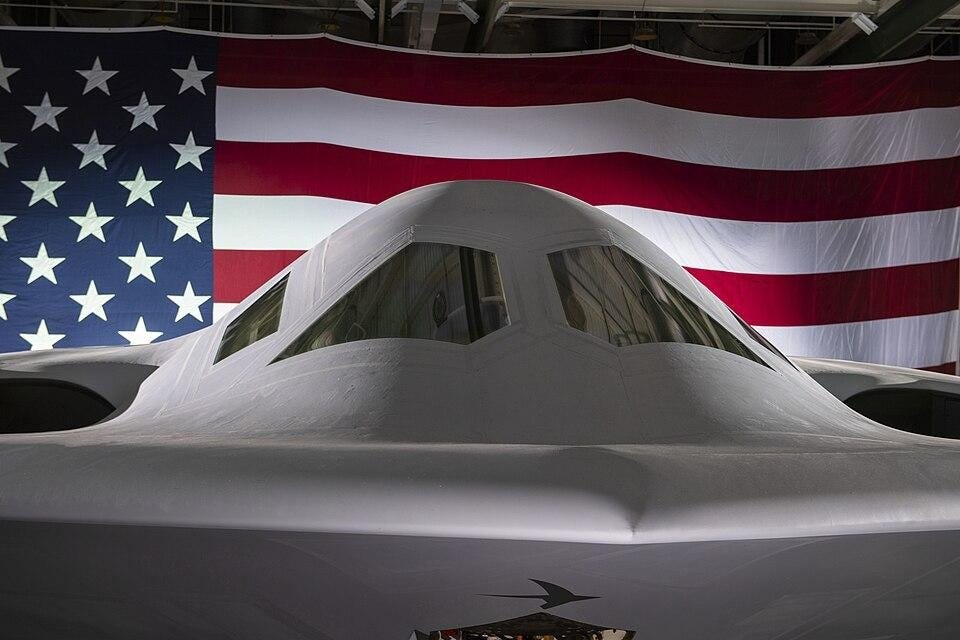
Let us give you a quick rundown on the B-21 Raider.
Primary Function: Nuclear-capable, penetrating strike stealth bomber
Lead Command: Air Force Global Strike Command
Aircraft Location: Edwards AFB, Calif. (test location); Planned: Ellsworth AFB, N.D.; Whiteman AFB, Mo.; Dyess AFB, Texas.
Active Variant: B-21. Developmental Long-Range Strike Bomber.
Dimensions: Span 140 ft. (estimated, approximate), Length 55 ft (estimated, approximate), Height 18 ft. (estimated, approximate)
Performance: Speed high-subsonic (estimated), range intercontinental.
Armament: Nuclear and conventional (planned)
Accommodation: Two pilots; autonomous control (planned).
Some of the details remained classified, including the number of Pratt & Whitney Turbofans and their maximum takeoff (TO) weight.
Dawn Patrol: How the B-21 Raider Redraws the Map of Allied Power
The arrival of the B-21 Raider isn’t just about sharpening the American spear—it’s about fortifying the entire network of U.S. allies, those who look to the United States to keep the balance, uphold deterrence, and bring the world’s most advanced warfighting capabilities to the table.
For nations sheltered by America’s nuclear umbrella—Japan, South Korea, Australia, the NATO alliance— it’s proof that the U.S. isn’t letting its strategic arsenal grow old and brittle.
With this modern stealth bomber, Washington sends a clear message: its commitments are solid, even as new nuclear powers rise and old rivals stir. The mere presence of the B-21 makes it more challenging for any adversary to question America’s resolve or probe for weakness.
But the Raider’s impact isn’t just in its presence—it’s in its ability to knit together allied forces tighter than ever. Built to work hand-in-glove with next-generation command and control, the B-21 opens doors for closer cooperation with friends who’ve invested in compatible systems. Britain, Australia, Japan, NATO partners—all stand to benefit as shared data, real-time targeting, and common threat pictures turn collective defense into something seamless, almost instinctive.
The B-21’s range means it can launch from home soil or allied bases, projecting power deep into contested regions. In the Indo-Pacific, partners are exploring new options for rapid response and deep-strike capabilities to counter the growing reach of potential adversaries. For NATO, it’s a deterrent that keeps Russia guessing, never quite sure where the next move might come from.
The Raider strengthens the web of partnerships—from the AUKUS alliance to Australia’s push for greater strike reach. Its integration signals that America’s commitment to these regions isn’t fading; it’s evolving, growing stronger and more sophisticated.
Defining Tomorrow’s Airpower
As the first light catches the B-21’s sleek form, its silhouette is a quiet promise on the flight line. The Raider isn’t just another aircraft—it’s a statement, a symbol that the United States will continue to invest in the future of airpower and its alliances. For every allied nation watching, the B-21 showed that America remains a steadfast partner.
Yet the bigger picture stretches further than deterrence. The B-21 is built to adapt and designed for a world where teamwork among allies is seamless, strategies are shared, and threats are met together.
As dawn breaks over the ramp, the aviation senses a new era unfolding—the B-21 lighting the way forward for shared strength and innovation in the skies.
This Week in Aviation History
In 1942 under the pale Pacific sun, the B-26 Marauder’s engines rumbled to life, ready for its first taste of combat.
What began as a baptism in the island-dotted expanse of the Southwest Pacific soon evolved—the Marauder’s destiny would carry it far beyond those waters. Most found themselves bound for the skies above Europe and the Mediterranean, where they carved out a legend at medium altitudes, flying between 10,000 and 15,000 feet.
The numbers tell a story as sharp as any memory. The B-26 became a byword for survivability, boasting the lowest loss rate of any Allied bomber in the war—less than half a percent.
That record was forged by speed, a tough airframe, and the steely discipline of crews drawn from across the world: Americans, Brits, Free French, Australians, South Africans, Canadians. Together, they piloted Marauders on more than 110,000 missions, delivering 150,000 tons of bombs onto enemy targets.
By war’s end, 5,266 Marauders had rolled off the line. One of them, now resting at the National Museum of the U.S. Air Force, once wore Free French colors in the final months of the fight.
Acquired from a Paris training facility in 1965, she stands today as a silent witness to the legacy of the 387th Bomb Group—a testament to the machine and the airmen who made history.
From “Widow Maker” to Legend
Aviators can almost feel the anticipation from that winter of 1939, when the Glenn L. Martin Company’s Model 179 first caught the Army Air Corps’ eye. America wanted a bomber faster and more advanced than anything before, and by November 1940—just fourteen months after the ink dried on the contract—the B-26 Marauder was airborne.
It was a machine ahead of its time: all metal, tricycle landing gear, and a wing loading that promised blistering speed. But with that innovation came risk. The Marauder’s high landing and takeoff speeds rattled rookie pilots, earning it grim nicknames—“Widow Maker,” “One-a-Day-in-Tampa-Bay”—and congressional scrutiny that nearly clipped its wings before it could prove itself.
Yet, as so often happens in aviation, the story turned with skill and tenacity. New training, revised tactics, and engineering tweaks transformed the Marauder from a feared adversary into an aviator’s ally.
When war called, the B-26 was ready. Marauders went into action almost immediately after the attack on Pearl Harbor. It was in 1942, when Marauders swept in low at Midway, torpedoes slung beneath their bellies, speed and daring their only armor.
From the sands of North Africa to the hedgerows of Normandy, the Marauder found its stride. By 1943, it was the workhorse of the Ninth Air Force, defining what medium-altitude bombing could be. Its crews—Americans, Brits, French, South Africans, Australians—flew over 100,000 missions, dropping 150,000 tons of bombs and earning the lowest loss rate of any Allied bomber.
More than 5,000 Marauders rolled off the line, and those who flew her never forgot: the machine once doubted became a legend, proof that bold designs and determined crews could change the course of a war.
Features: Guns, Speed, and Resolve
The B-26G Marauder wasn’t just a bomber—it was muscle and nerve wrapped in aluminum and steel. Eleven .50-caliber machine guns bristled from its fuselage and turrets, ready to answer any threat. Beneath its broad wings, it could carry up to 4,000 pounds of bombs, each mission a promise of thunder far behind enemy lines.
Twin Pratt & Whitney R-2800 radials—each churning out 2,000 horsepower—gave her the speed of a hunted shadow: 285 miles per hour flat out, 190 to cruise. She could stretch her legs for 1,100 miles and climb to nearly 20,000 feet, flying high enough to dodge the worst of the flak while still packing a punch.
With a 71-foot wingspan and just over 58 feet from nose to tail, she was compact for a medium bomber, but at 37,000 pounds fully loaded, she landed heavy, ready, and unbowed.
B-26 Legacy: Benchmark in the Clouds
They remember the B-26 Marauder as an aircraft forged by adversity. Because of early problems, she drew wary eyes. But as the months passed, engineers reworked her lines while determined crews learned her rhythms, turning doubt into confidence. Under their hands, the Marauder transformed into a benchmark for medium bombers—fast, precise, and almost uncanny in her ability to bring her crew home.
Flying between 10,000 and 15,000 feet, she defied the odds, posting the lowest loss rate of any Allied bomber, less than half a percent even under the guns of heavy enemy defenses.
Her reputation crossed borders—Americans, Brits, Free French, Australians, South Africans, and Canadians all put their trust in her during the war’s fiercest campaigns.
As they walk the length of her fuselage, it’s clear. Each rivet and gun mount on the Marauder carries the imprint of lessons learned in the crucible of war—balanced, powerful, and ever ready to take on the unknown. Her legacy endures today, a testament to innovation and resilience that continues to inspire those who look to the skies.
In Case You Missed It
The F-35 has been a roller coaster of a program - from perceived failure to the fifth gen fighter:
Photo Outlet
Every issue of Hangar Flying with Tog gets you a free image that I’ve taken at airshows:
Feel free to use these photos however you like, if you choose to tag me, I am @pilotphotog on all social platforms. Thanks!
Post Flight Debrief
Like what you’re reading? Stay in the loop by signing up below—it’s quick, easy, and always free.
This newsletter will always be free for everyone, but if you want to go further, support the mission, and unlock bonus content like the Midweek Sortie, consider becoming a paid subscriber.
Your support keeps this flight crew flying—and I couldn’t do it without you.
– Tog



